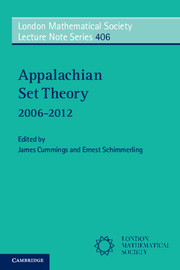Book contents
- Frontmatter
- Contents
- Contributors
- Introduction
- 1 An introduction to ℙmax forcing
- 2 Countable Borel equivalence relations
- 3 Set theory and operator algebras
- 4 A tutorial on Set Mapping Reflection
- 5 An introduction to hyperlinear and sofic groups
- 6 Aronszajn trees and the SCH
- 7 Iterated forcing and the Continuum Hypothesis
- 8 Short extender forcing
- 9 The complexity of classi?cation problems in ergodic theory
- 10 On the strengths and weaknesses of weak squares
- 11 Proper forcing remastered
- 12 Set theory and von Neumann algebras
- 13 The HOD Dichotomy
13 - The HOD Dichotomy
Published online by Cambridge University Press: 05 December 2012
- Frontmatter
- Contents
- Contributors
- Introduction
- 1 An introduction to ℙmax forcing
- 2 Countable Borel equivalence relations
- 3 Set theory and operator algebras
- 4 A tutorial on Set Mapping Reflection
- 5 An introduction to hyperlinear and sofic groups
- 6 Aronszajn trees and the SCH
- 7 Iterated forcing and the Continuum Hypothesis
- 8 Short extender forcing
- 9 The complexity of classi?cation problems in ergodic theory
- 10 On the strengths and weaknesses of weak squares
- 11 Proper forcing remastered
- 12 Set theory and von Neumann algebras
- 13 The HOD Dichotomy
Summary
The sixteenth Appalachian Set Theory workshop was held at Cornell University in Ithaca on April 7, 2012. The lecturer was Hugh Woodin. As graduate students Jacob Davis and Daniel Rodríguez assisted in writing this chapter, which is based on the workshop lectures.
Introduction
This paper provides a more accessible account of some of the material from Woodin [4] and [5]. All unattributed results are due to the first author.
Recall that 0# is a certain set of natural numbers that codes an elementary embedding j : L → L such that j ≠ id ↾ L. Jensen's covering lemma says that if 0# does not exist and A is an uncountable set of ordinals, then there exists B ∈ L such that A ⊆ B and ∣A∣ = ∣B∣. The conclusion implies that if γ is a singular cardinal, then it is a singular cardinal in L. It also implies that if γ ≥ ω2 and γ is a successor cardinal in L, then cf(γ) = ∣γ∣. In particular, if β is a singular cardinal, then (β+)L = β+. Intuitively, this says that L is close to V. On the other hand, should 0# exist, if γ is an uncountable cardinal, then γ is an inaccessible cardinal in L. In this case, we could say that L is far from V. Thus, the covering lemma has the following corollary, which does not mention 0#.
- Type
- Chapter
- Information
- Appalachian Set Theory2006–2012, pp. 397 - 419Publisher: Cambridge University PressPrint publication year: 2012
- 2
- Cited by

